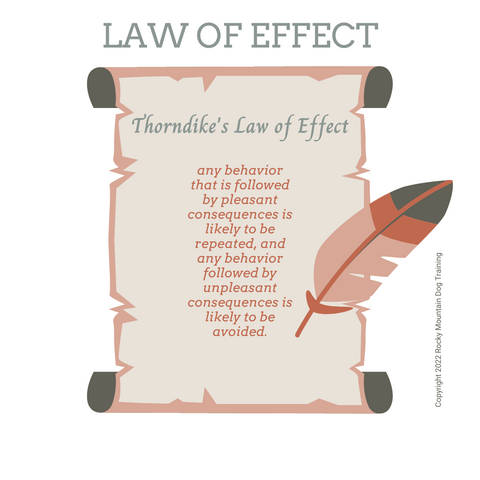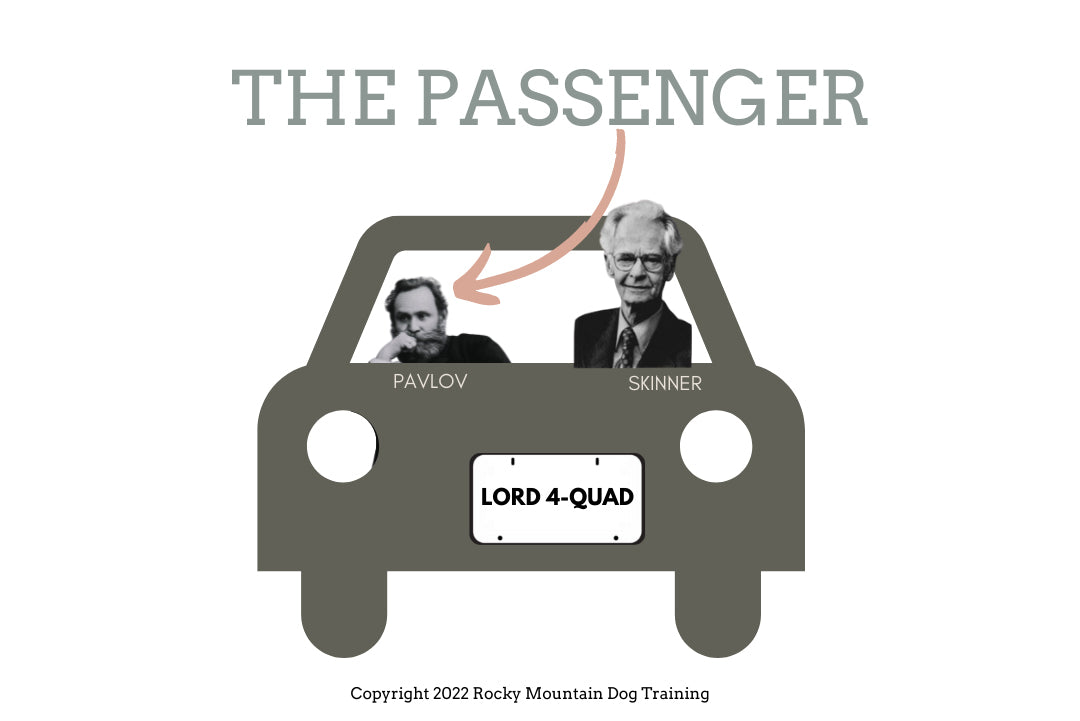Once upon a time, an American Psychologist by the name of Edward Thorndike was credited with the development of The Law of Effect. The law of effect applies to every species on our planet and is occurring with all beings both through natural and artificial processes.
Thorndike's Law of Effect states that any behavior that is followed by pleasant consequences is likely to be repeated, and any behavior that is followed by unpleasant consequences is likely to be avoided.
It is the law of the land.

In science, a law has a repeatable and provable outcome supported by empirical evidence collection. Laws predict with accuracy the results of certain conditions. Laws describe an observed phenomenon.
Laws are supported by theories. A theory seeks to explain why the phenomenon exists and is supported by evidence. In the ABA model of teaching dogs, Skinner's Operant Conditioning (O.C.) Theory - the 4 quadrants of behavior is the primary model, and focuses specifically on observable behaviors. Things we can witness. External States.
If you're not familiar with the 4 quadrants, here's the skinny:
- Positive Reinforcement (R+): The introduction (+) of a desirable or pleasant stimulus after a behavior, increasing the likelihood a behavior will reoccur
- Positive Punishment (P+): The introduction (+) of an undesirable or unpleasant stimulus after a behavior, decreasing the likelihood a behavior will reoccur
- Negative Reinforcement (R-): An uncomfortable or otherwise unpleasant stimulus is removed (-) following a behavior, increasing the likelihood a behavior will reoccur
- Negative Punishment (P-): A good or desirable stimulus is removed (-) to reduce the occurrence of a behavior.
So… Punishment decreases behavior, Reinforcement increases behavior and the +/- means a stimulus is added (+) or removed (-).

If this is your first trip to the majestic land of ABA behavior change, you might be wondering how this plays out in a training session. For that we move on to the ABCs of Behavior. But first, the relevant definitions:
Antecedent – a stimulus or event that immediately precedes a behavior, which sets the occasion for the behavior to occur; includes cues, setting events, and establishing operations
Behavior – Anything an individual does, given certain conditions, which can be observed and measured
Consequence – An event or stimulus that immediately follows a behavior that influences the future strength of the behavior. Strength refers to any behavioral characteristic that can be measured.
Here are a couple of examples of the ABCs at work:
- ex: I prompt dog to sit (Antecedent), Dog Sits (Behavior), Dog Gets Treat (Consequence). Sitting behavior increases in these conditions. Outcome = R+
- ex: I walk in door (Antecedent), Dog Jumps on me (Behavior), I remove access to myself from the dog (Consequence). Outcome = jumping behavior decreases in these conditions. Outcome = P-

Super Important Side note: Only the learner gets to define what is reinforcing and what is punishing. We can make an educated guess, but since we as trainers can't ask dogs, the only way to confirm effect is to observe the shift in frequency of the learner's behavior.
- Does frequency of behavior go up? It is being reinforced.
- Does frequency of behavior go down? It is being punished
- If neither are happening or we receive an unintended frequency shift, we must reassess our selected consequences.
While operant conditioning (O.C.) is incredibly important to our work, the sole focus with it is on observable behaviors. There are other lenses which we can and should look at our learner through that can compliment our efforts. Since we all experience times when our internal state differs significantly from what is observable to others, not accounting for internal state can be problematic.
Classical Conditioning (C.C.) is one such lens that helps us consider emotions -- internal states, and is also happening during many operant procedures in dog training. Let's define it:
Classical Conditioning (C.C.) – a learning process that occurs when two stimuli happen sequentially frequently: a response which is at first elicited by the second stimulus is eventually elicited by the first stimulus alone.
A very simplified example to help you grasp classical conditioning as an unconscious learning side effect in training is this:
When my dog and I train, I typically wear a bait bag. Even though I'm training observable behaviors in our sessions, through no additional effort on my end, he learned that when I put on a bait bag, treats will follow. He wasn't born with an affinity for me putting on bait bags, I never purposefully set out to teach him to like them, but because my putting it on (event a) frequently predicts that he will get treats (event b), he has developed a happy, anticipatory response to this action.
This is because within the ABCs of behavior, the A – the antecedent, and the C – the Consequence are both stimuli and are frequently sequential, so the dog unconsciously develops feelings about the first of the two stimuli as a result of being followed repeatedly by the second stimuli.
He used to think, "Hooray!" when I was handing him a treat, but now he thinks, "Hooray!" when he simply sees the bait bag because it too is associated with treats. Whenever using the ABC model, we must consider in our setup if Classical Conditioning is along for the ride.
In this ABC style of training, it is wise to think of O.C. as the driver, and C.C. as the passenger.

- O.C. is a contingent relationship. The dog must do something to get the consequence.
- In Classical Conditioning (C.C.), the learner is learning by observing 2 events they have no control over that occur sequentially often. Over time, a pattern emerges. They might think, "I noticed that every time x (event a) happens, y (event b) follows."
Selecting Quadrants
One might wonder why some trainers are so wholly committed to positive reinforcement as their primary quadrant in training. This is because of the classical conditioning side effects taking place in the background. When a dog is learning via positive reinforcement (R+), they're also unconsciously developing warm fuzzies about all the things that come with it via its passenger, classical conditioning. When using R+, because the consequence is an unconditioned stimuli, unconditioned meaning the dog was born already loving it (in this case), dogs begin to experience wonderful side effects happening behind the scenes. They learn to enjoy training, to enjoy the presence of the trainer, they learn to enjoy the trainer's hands coming near, they start to like their voice, they enjoy the environments they're learning in, the bait bags they see, even props like a settle mat can produce joy because they predict a good "event b" - something the dog inherently likes. Because dogs are at their best when they feel happy and safe, this lends to a very strong case for positive reinforcement and is why we work so hard to arrange for only minimal use of punishment in training programs and further, if punishment is needed, we select the punishment quadrant we use carefully.
Remember that even when Lord 4-Quad is in the driver's seat, Pavlov and his classical conditioning are along for the ride.

The Passenger
In the majestic land of behavior, it is true that we have all four quadrants to use at our disposal. The question is, should we? And to what degree of intensity? We must again look to the passenger. Why are we so hung up on the passenger? Well, because with him he brings along emotional baggage.
Classical Conditioning is responsible for the development of Conditioned Responses. A subset of these are called Conditioned Emotional Responses or CERs. There are +CERs and –CERs and because we use plus and minus signs with no uniformity in this field, this time the, + means positive and – means negative. Sigh. I'll just define them because it's easier that way:
- +CER (Positive Conditioned Emotional Response) = happy anticipation. "Yippee!"
- -CER (Negative Conditioned Emotional Response) = anticipation of something yucky, at times fear-inducing – fear is something we should all actively avoid installing in dogs.
In using an R+ procedure, Event A would predict a favorable event B. This means low risk for unintended undesirable fallout from the passenger.
When we use punishment of either variety with sequential frequency in O.C., the dog predictably begins to make an emotional (C.C.) association as a side effect.
Are all punishers created equal? No.
We strive to follow the Least Invasive, Minimally Aversive guidelines in selecting our method of behavior change, so if we must use punishment, we would honor our learner best by opting for consequences that have a low risk of behavior fallout from the dog – a low risk of causing fear.
For me, that would be Negative Punishment (P-). If you'll recall, P- is the removal of something to decrease the likelihood of a behavior.
Let's go back to our ABCs to explore a P- scenario.

Antecedent:
I walk in the door
Behavior:
Dog Jumps on me
Consequence:
I remove myself from the room (and the dog).
Question:
Does my selected consequence risk inducing fear in this dog?
Unlikely. Minimal Risk for causing fear.
Please note, I'm assuming the dog is behaviorally healthy in this example. Losing access to me for a dog with Separation Anxiety would indeed induce fear. Always consider the make up of the dog in front of you.
When selecting tools for modifying behavior, your safest bet for the vast majority of training with regard to your passenger are R+ and occassional P-. This is the gold standard for using Operant Conditioning (O.C.).

We need to be exceptionally careful about how old Lord 4-Quad is permitted to drive on account of his passenger because the choices we make in O.C. can and often do collide with the effects of classical conditioning (C.C.) and if we're not careful, this can cause BIG FEELINGS. If we are thoughtful about our choices, we can avoid harmful unintended consequences to the learner. We try desperately to avoid the crash causing a -CER.

Fear is super easy to install on a dog and really freakin' tough to eliminate, so just don't do it! Remember your passenger.
Is Your Consequence Risky?
If selecting to use P+, particularly when the consequence runs a high risk to cause fear or pain, we know that behind the scenes the passenger is building a –CER to things in the environment.
If you're treating a dog who barks at strangers, and you're following the ABCs of behavior to decrease barking, what happens when your operation looks like this?
 Can using this P+ method change how your dog feels about strangers given the C.C. side effect? Absolutely.
Can using this P+ method change how your dog feels about strangers given the C.C. side effect? Absolutely.
What about dogs that lunge excitedly at other dogs on leash? If you opt for painful P+ to decrease the lunging, say the dog gets a shock that hurts, how does the passenger handle information for the dog?
You might think – they don't associate it with the other dog, they associate it with the barking. The reality is, they associate it with both because both learning processes are at play. For that matter, they can also associate it with any other consistently present stimuli superstitiously. Is a kid often riding by when the dog is delivered P+? They may learn to fear kids on bikes too! This is behavioral fallout at play. Consciously, through the ABCs, the dog learns that if they lunge at other dogs, they get P+ (shock) so barking decreases. But because the dog lunges most frequently at the appearance of other dogs, unconsciously, the dog's feelings about other dogs begin to shift. That excitement perhaps turns to dread, fear, stress… They might think, "dang it, every time a dog appears, it's gonna be painful. I'm scared."
"Maybe if I bark at them they'll go away."
And here's where it gets really tough. Because painful P+ works quickly to kill a behavior, it's unfortunately HIGHLY reinforcing to the human. Dog lunges, they press button, lunging stops. It does work! Nobody is denying that.
Now, if it's reinforcing to the human, what happens next? You guessed it, button pressing goes up!
When Pavlov Takes the Wheel
Back to that pesky passenger. Did you know that sometimes he'll move into the driver's seat? Not only that, when C.C. is driving, O.C. happens in the background! Crazy, I know! I'll keep this brief but it's important: If a dog is experiencing fear, they will use coping skills (observable behaviors) to stay safe. And this is why you must consider both in your application.
Removing coping skills without an established and healthy replacement behavior is dangerous.
When fear is present, if we punish out a coping skill we don't like using O.C. but we fail to account for the dog's emotions, they'll try something else to cope. Coping skills help the learner feel safe. What happens when the dog becomes scared of dogs as a result of our choice for P+? They'll probably start barking at dogs to get them to go away. Does that get punished out too? What then? They move on to growling? What if that gets punished out too? What then? The passenger is always going to come into play with frequently sequential stimuli, so we best afford for it in the way we plan our training.
Punishing a learner for the observable behavior that reflects a scared internal state without helping them access appropriate coping skills through learning is not ok. We have an obligation to help them feel safe again. In this scenario, if we just keep punishing out symptoms without addressing emotion, we rid them of their distress signals, their warning signals, and we can create a truly dangerous dog through no fault of their own.
When choosing methods, we must always account for the passenger. Both modes of learning are at play in Thorndike's Law of Effect. Ultimately, dogs who feel safe and who are happy and free from fear are safer for everyone and have a higher quality of life. This increases our quality of life too.
How will your method impact the dog as a result of the passenger?

